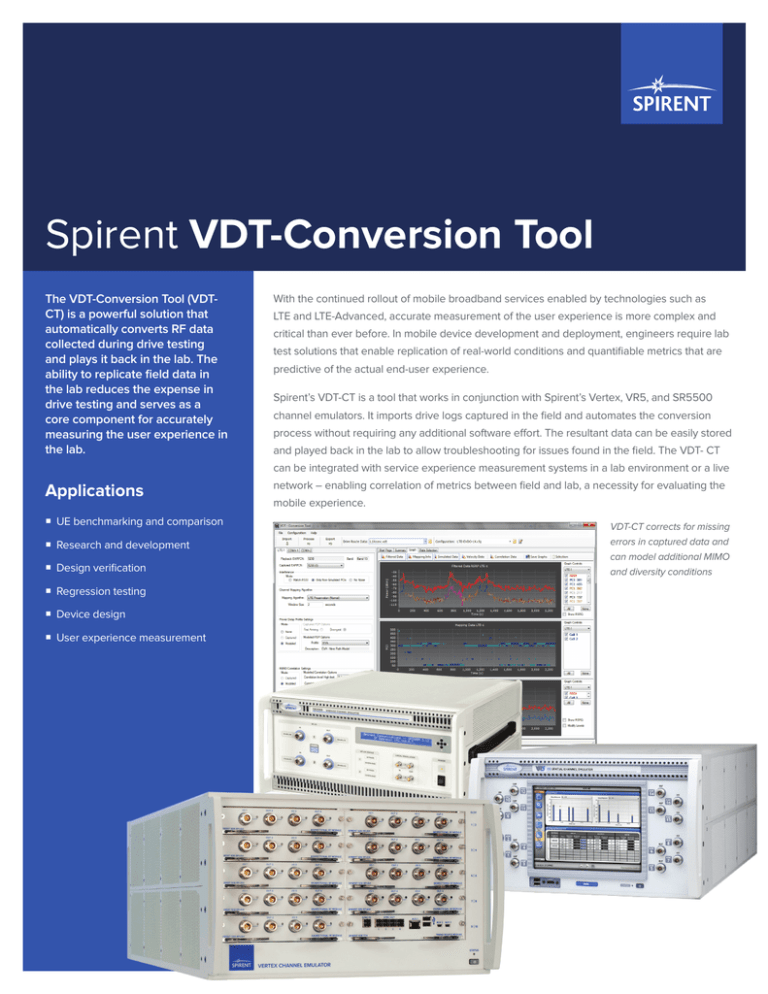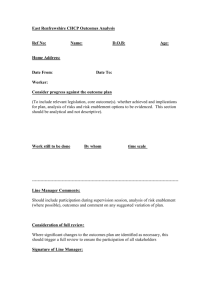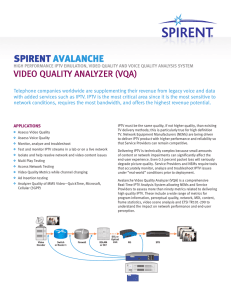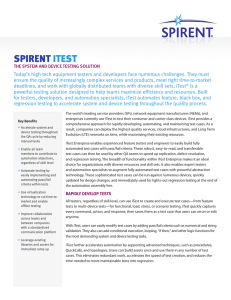
Spirent VDT-Conversion Tool
The VDT-Conversion Tool (VDTCT) is a powerful solution that
automatically converts RF data
collected during drive testing
and plays it back in the lab. The
ability to replicate field data in
the lab reduces the expense in
drive testing and serves as a
core component for accurately
measuring the user experience in
the lab.
With the continued rollout of mobile broadband services enabled by technologies such as
LTE and LTE-Advanced, accurate measurement of the user experience is more complex and
critical than ever before. In mobile device development and deployment, engineers require lab
test solutions that enable replication of real-world conditions and quantifiable metrics that are
predictive of the actual end-user experience.
Spirent’s VDT-CT is a tool that works in conjunction with Spirent’s Vertex, VR5, and SR5500
channel emulators. It imports drive logs captured in the field and automates the conversion
process without requiring any additional software effort. The resultant data can be easily stored
and played back in the lab to allow troubleshooting for issues found in the field. The VDT- CT
can be integrated with service experience measurement systems in a lab environment or a live
Applications
UE benchmarking and comparison
Research and development
Design verification
Regression testing
Device design
User experience measurement
network – enabling correlation of metrics between field and lab, a necessity for evaluating the
mobile experience.
VDT-CT corrects for missing
errors in captured data and
can model additional MIMO
and diversity conditions
Spirent VDT-Conversion Tool
Key features
Supports all major mobile wireless
technologies on all bands, including
WiFi
Supports high-speed train and air
applications
Supports QXDM logging in native
format
Replaying the live network in the lab
VDT–CT takes drive logs captured in the field and converts and maps them onto the lab test
setup for realistic playback. It supports lab connections of up to 40 RF channels, which can be
configured to:
Unidirectional 2x2 downlink for 20 cells
Unidirectional 4x2 for 10 cells
Bidirectional 2x2 for 10 cells
Unidirectional 2x8
Bidirectional (FDD or TDD) SISO for 20 cells
Hybrid 2x2/1x4
Bidirectional 4x2 for 5 cells
Unidirectional Dual 2x2 + Quad 1x2
Hybrid logging supports
simultaneous scanner and phone
logging (on up to 3 devices) to
enhance data collection for LTE,
CDMA, and WCDMA
VDT–CT supports the processing of all major mobile technologies, including:
FDD LTE, TD-LTE
EV-DO, cdma2000
HSPA+, HSDPA
1X TD-SCDMA
EDGE, GPRS, GSM
Wi-Fi 802.11n/ac 2.4GHz, and 5GHz
All data can be graphically
displayed to allow easy and intuitive
analysis
Users can capture the drive logs in a variety of popular logging tools:
QXDM in ISF format
Transcom
Supports multi-system processing
JDSU (stand-alone or with up to 3 UEs)
Rohde & Schwarz
Enhanced Noise Simulation
Anite Nemo
PCTEL
provides fine-tuned noise level
control
Benefits
Reduced development costs.
Minimize the need for expensive
drive testing.
Reduced time-to-market.
Accuver XCAL
After they are imported, multiple logs can be concatenated or merged to generate more
sophisticated logs for conversion.
In a drive route, users could see more than a hundred cells. It is unlikely most of the time that
the lab setup can match the number of cells in the field. However, engineers still want the
realistic cell dynamics as seen by the UE in the field for lab testing. VDT-CT makes it possible by
introducing a number of mapping algorithms to suit different situations:
Fewer physical drive tests eases
Serving cell preservation in normal and harsh conditions
the strain of tight deployment
Cell Preservation in normal and harsh conditions
schedules. Fix more problems
quickly in the lab rather than in the
field.
Enhanced product quality.
One-to-one mapping of strongest cells or longest appearing cells
High-speed applications
An absolutely repeatable drive test
As users move into faster mobility scenarios such as traveling on high speed trains and aircraft,
on a bench top. Quickly isolate
devices are subjected to higher Doppler spreads. VDT-CT has the capability to import and
RF issues that might otherwise go
analyze logged data at speeds up to 1620km/hr (1007mph).
unnoticed until after deployment.
Simplified, efficient testing.
Seamless integration with Spirent’s
Vertex or VR5 and XD5 Multilink
Duplexer reduces necessary
cabling and increases testing
capacity.
2 | spirent.com
Rich and intuitive graphical user interface
In addition to the playback files for the channel emulators, VDT- CT also provides a rich set of graphics for intuitive analysis and verification.
It visualizes the mapping process and the dynamics of cells during the drive as seen by the logging device and the device under test.
The VDT-CT graphical interface includes the
following:
Composite power graphics of multitechnologies for inter-RAT and handover
analysis
Filtered data graph for drive log data
visualization
Mapping data to show the results of cell
mapping algorithm
Geographic maps with many standard Google
Map controls for drive route visualization and
selection
Selective call event identifiers (such as drops
and handovers) for adding or removing
instances from the drive test route
VDT-CT shows events like call origination, handover (idle and active), call drop, and throughput on the
map along the route
Simplified connections and
greater capacity
Spirent’s XD5 Multilink Duplexer allows a
seamless integration with Vertex or VR5 that
drastically simplifies cable connections and
increases cell testing capacity. The VDT- CT
software detects the XD5 and displays its
configuration editor, which allows XD5 provisioning
and guidance for the cabling necessary for the
chosen drive test. The XD5 eliminates external
duplexers, splitters, and combiners, and reduces
external cabling by almost half. It has a flexible
architecture to support a wide variety of drive test
scenarios with configurations of up to 16 SISO or
eight 2x2 MIMO eNodeBs. See the XD5 datasheet
for more information.
XD5 provisioning via VDT-CT installed on the Vertex channel emulator
spirent.com | 3
Spirent VDT-Conversion Tool
Spirent services
Spirent Global Services provides a
variety of professional services, support
services and education services—all
focused on helping customers meet
their complex testing and service
assurance requirements. For more
information, visit the Global Services
website at www.spirent.com or contact
your Spirent sales representative.
VDT-CT integration for end-to-end performance testing
in the lab
The VDT-CT is a key component in Spirent’s end-to-end solution for user experience
performance testing in the lab environment. The VDT-CT maps the RF data captured from the live
network to Spirent’s Vertex, VR5, or SR5500 Spatial Channel Emulator, which then emulates the
RF environment in the lab. Spirent’s channel emulators can connect directly to your lab-based
network infrastructure or to one of Spirent’s network emulators. And for a more comprehensive
solution, Spirent’s service experience measurement systems can be integrated to provide voice/
video quality, call performance, data speed, battery consumption, and multi-service performance
metrics, enabling correlation between field and lab tests and accurate evaluation of the user
experience.
Ordering Information
Part Number
Description
VDT-CT
A Single User License for VDT - Conversion Tool
VR5-VDT-CT-PLAYBACK
VDT - Playback License for VR5
VCE6-VDT-CT-PLAYBACK
VDT - Playback License for Vertex
SR5500-VDT-CT-PLAYBACK
VDT - Playback License for SR5500
VDT-CT-XD5
XD5 Integration License
VDT-CT-ASA
VDT-CT Annual Service Agreement
VDT-CT-LTE
LTE Technology Enablement
VDT-CT-UMTS
WCDMA & GSM Technology Enablement
VDT-CT-CDMA
CDMA Technology Enablement
VDT-CT-TDSCDMA
TD-SCDMA Technology Enablement
VDT-CT-LTEUMTS
LTE and UMTS Technology Enablement
VDT-CT-LTECDMA
LTE and CDMA Technology Enablement
VDT-CT-WIFI
WiFi Technology Enablement
VDT-CT-QXDM
QXDM ISF Log Data Format Conversion
VDT-CT-JDSU
JDSU Scanner Data Format Conversion
VDT-CT-JDSU-MULTI-UE
JDSU Scanner Data Format Conversion with up to 3 UEs
VDT-CT-ACCV
Accuver Log Data Format Conversion
VDT-CT-NEMO
Anite Nemo Scanner Data Format Conversion
VDC-CT-PCTEL
PCTEL Scanner Data Format Conversion
VDT-CT-TRANSCOM
Transcom Scanner Data Format Conversion
VDT-CT-ROMES
Rohde & Schwarz TSMW Scanner Data Format Conversion
spirent.com
AMERICAS 1-800-SPIRENT
+1-800-774-7368 | sales@spirent.com
EUROPE AND THE MIDDLE EAST
+44 (0) 1293 767979 | emeainfo@spirent.com
ASIA AND THE PACIFIC
+86-10-8518-2539 | salesasia@spirent.com
© 2016 Spirent Communications, Inc. All of the company names and/or brand names and/or product names and/or logos referred to in this
document, in particular the name “Spirent” and its logo device, are either registered trademarks or trademarks pending registration in accordance
with relevant national laws. All rights reserved. Specifications subject to change without notice. Rev. G | 05/16








